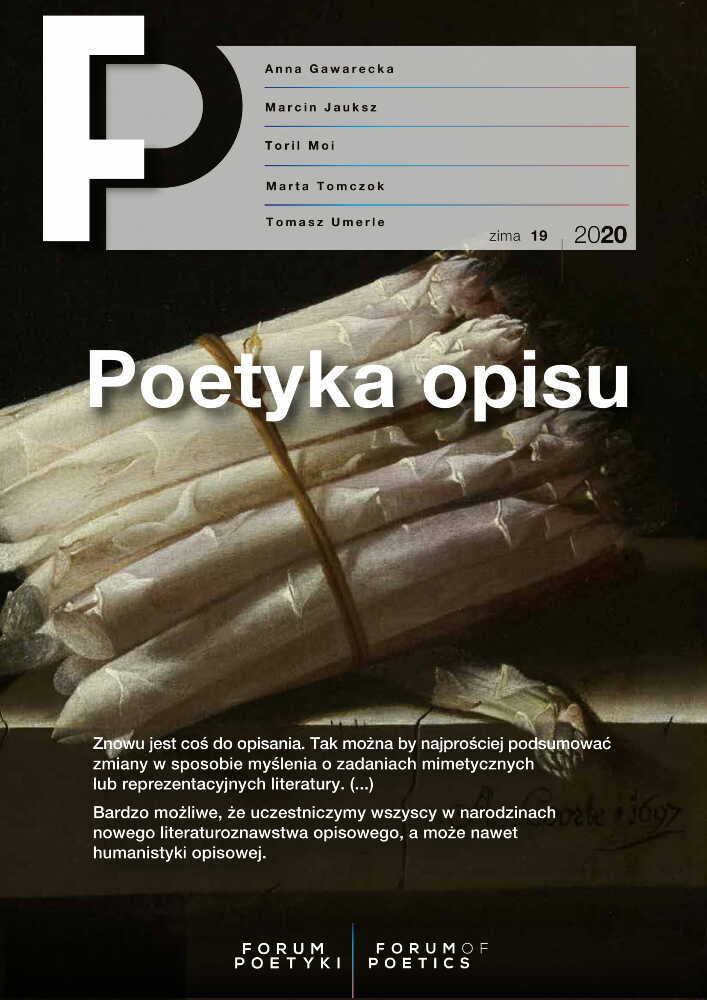Nr 19 (2020)
Jest jeszcze coś do opisania. Może to być najłatwiejszy sposób podsumowania zmian w sposobie myślenia o mimetycznych lub reprezentatywnych zadaniach literatury. Rzeczywistość jest definiowana na różne sposoby - spekulatywna, traumatyczna, eksperymentalna, pamięciowa, emocjonalna itp. - i trwa, a przynajmniej jest szalona poza zapisami. Tak więc opis jest nie tylko retoryczną maszyną wytwarzającą iluzoryczny „efekt rzeczywistości”, zgodnie ze znaną formułą Rolanda Barthesa, ale jest jednym z kluczowych elementów każdego przedsięwzięcia językowego, które próbuje opisać pewną rzeczywistość w wynalazku sposób, próbując znaleźć swoją osobliwą, ponownie czującą ontologię.
Niedawno Toril Moi poprosiła także o opis jako ważne narzędzie badawcze ( na ten temat wydrukowaliśmy fragment jej Rewolucji Zwyczajnej ). Dyskutowano również o znaczeniu opisu w różnych dyscyplinach naukowych (zainicjowane przez Sharon Marcus, Heather Love i Stephen Best), ponieważ jest to procedura naukowa, która jest stale stosowana między innymi w badaniach medycznych, naukowych, socjologicznych i psychologicznych, między innymi . Jest to ważny obszar uznawania literatury fachowej i językoznawstwa, który muszą uwzględniać wszystkie inne dyscypliny.
Zagadnienie poetyki opisu zyskuje zatem na znaczeniu jako szczególnie interesujący obszar badań i rozwoju pomysłów koncepcyjnych. Przypominamy zatem w tym numerze, że temat ten został dokładnie przestudiowany w tradycji badań strukturalistycznych w Europie Środkowej. Klasycznych ustaleń teoretycznych na ten temat dokonał Janusz Sławiński, którego współczesną lekturę proponuje Gerard Ronge. Interesujący opublikowany niedawno tom czeskich badaczy korzysta z archiwów czechosłowackiego
strukturalizmu, a jednocześnie analizuje potrzeby aktualnych badań nad opisem w kulturze multimedialnej (Anna Gawarecka). Rozwija zagadnienie opisu jako elementu poetyki najnowszych gier wideo (Rafał Kochanowicz).
Wreszcie opis staje się decydującym elementem tekstów literackich, które dotyczą najbardziej bolesnych doświadczeń. Karl Ove Knausgård napisał swoją słynną Moją walkę, opierając się na przekonaniu, że śmierć nie może dłużej podtrzymywać tezy o czysto językowej naturze rzeczywistości. Dlatego warto ponownie zapoznać się z ważną polską książką literacką z lat 90., Zapiski z nocnych dyżurów Jacka Baczaka, z jego opowieściami o ludziach umierających w hospicjach, dla których w tym czasie prawdopodobnie nie mieliśmy wystarczająco chwytliwych języków badawczych. Być może prześledzenie samej poetyki opisu Baczaka pozwala lepiej zrozumieć problemy jego wzruszającej książki (Justyna Szczęsna). Prawdopodobnie dlatego miniony, martwy świat polskich prowincji lat 60. i 70., ukazany uporczywie w poezji Piotra Szewca w jego zaskakującej formie literackiego animizmu, tak bardzo potrzebuje wrażliwego opisu (Marta Tomczok). Warto też powrót do złotej ery opisu literackiego, do czasów wielkiej powieści realistycznej, aby zobaczyć subtelności wiedzy psychologicznej znaczenia opisem w Bolesława Prusa Lalka (Marcin Jauksz).
Proponując temat „poetyki opisu”, po raz drugi zdarzyło się nam, jako redakcji, wywołać nieoczekiwanie liczne reakcje badaczy i badaczy. Chcemy przywrócić ten konceptualny zapał, dlatego przygotowaliśmy dwa zagadnienia na ten temat. Jest bardzo możliwe, że wszyscy uczestniczymy w narodzinach nowej literatury opisowej, a może nawet humanistycznej.
